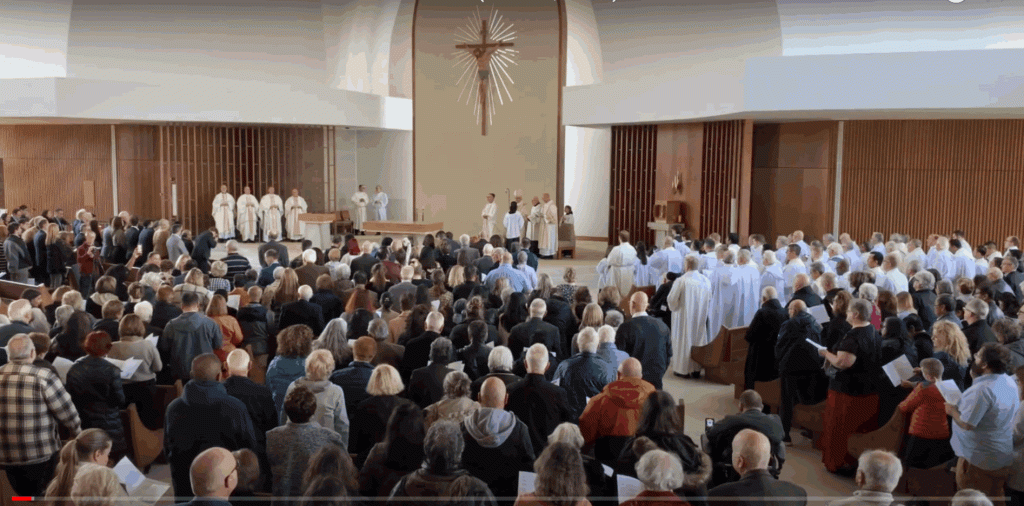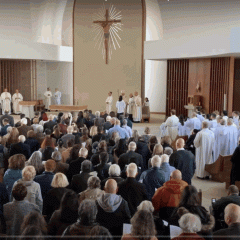catholic faith
Where Is My Heart?

21st Sunday Ordinary Time
Fr. Mark Gatto
Preached: August 25, 2024
“Lord, to whom shall we go?” This faith statement of Peter should push each of us to reflect on the question, to who do I belong? Where is my heart? Today, you have decided to come here to this church to celebrate the Eucharist. You left your homes and came here. In doing that you have said, at least symbolically, that you want to belong to God above all else, that you want your heart to be with the Lord. To whom shall we go? To the Lord.
Today, I want to do something a little different. Since we entered our new church building last October I have been wanting to use a homily to describe our church design as a way to see what it teaches us about who we are as the church, and what we are doing here. As Catholics we say that the way we pray is the way we believe. Our church design is not just practical, it teaches us about our Catholic Faith.
I want to begin outside the actual church itself, to the Narthex or gathering area. We have a large gathering area at our entrance. Why? Because we do not come here as independent, private people to meet Jesus alone. We assemble as the people of God, we gather together as the church, called to be the body of Christ. A gathering area reflects that we are assembling together to meet the Lord as one body.
At the entrance of our church is the baptismal font. It is a reminder that we first entered the church through the waters of baptism. We make a sign of the cross with water from that font or from the side fonts to remember our baptism. In baptism we were united to Jesus and entered the mystery of his death and resurrection.
Here in the church, the centre of our space is the Altar. The Altar is where the Sacrifice of the Mass takes place. It is a sign of the self-giving love of Jesus reflected in the words of consecration when the priest speaks those words of Jesus from the Last Supper, “this is my body given up for you.” The Altar is also a table, as the Sacrifice of the Mass is also a Sacred Banquet as we look forward to the eternal banquet of Heaven. In our Altar, there are relics from the former Altar at Our Lady of Lourdes and a new relic of St. Catherine of Siena. The clergy kiss the Altar during the procession to remind us of our connection with all the saints who have gone before us through the ages who also celebrated this Eucharist.
The Ambo or Lectern, is like a second table, the table of the Word. From here we are fed from the Word of God. The Word and the Sacrament go together. For this reason the design of the Altar and Ambo use the same basic design and same stone to show that they go together.
The presider’s chair reflects the priest or bishop as a Sacrament of Jesus gathering us together and leading us in this Eucharistic action.
The Pews are also important as they are to reflect that all the people of God, all the baptized, are a priestly people and are to be fully involved in the action of the Mass. When I look out at you during the Mass I see the body of Christ.
We have two stones in the floor. Near the baptismal font is a dove with a branch. It is a symbol of peace, a symbol of our salvation through the waters of baptism, calling to mind the Ark in which the people were saved from the great flood. At the front we have a symbol of the Chi Rho, one of the earliest Christian images reflecting the first two Greek letters of the word, Christ. You see it as you come forward in procession to receive the real presence of Jesus in Holy Communion.
Finally, behind our Altar on our reredos is the carved Crucifix. It is not primarily a sign of suffering, but a sign of self-giving love that all of us are called to embrace following Jesus. The rays of light are a reminder of the Resurrection, that love overcomes death.
There are several other aspects of our church facility that are meant to lead us into our personal private prayer. The tabernacle, from which we bring communion to the sick, shut-ins and the dying. It is also a place of our private prayer in the presence of Jesus outside of Mass times. We have two shrines, the Holy Family Shrine and St. Catherine of Siena Shrine with candles to light as symbols of our prayers of intercession rising up to God. Many of you light candles as you pray for family and friends. At the entrance of our building is the Corpus Christi Adoration Chapel, recalling one of our former parishes. It is a peaceful place for private prayer in the presence of Jesus, the bread of life. In our parking lot, before we even enter this building, there is a Grotto of our Lady of Lourdes, our other former parish. It is a place for reflection and prayer united with Mary.
“Lord, to whom shall we go?” We come to this church to celebrate the Eucharist, to pray together as the body of Christ united with Jesus. By coming here we are saying that we desire to belong to the Lord, to allow our hearts to dwell in Jesus. We choose to stay with the Lord.
The Catholic Faith Video Series: Your Tough Questions Answered [Video #8]
Question: I’m wondering if a child can be baptized into the Catholic faith if neither of the parents are Catholic. In fact the mother is a mostly non-practising Hindu and the father has never been baptized into any religion. I am the father’s step-mother and I am a practicing Catholic. The parents would like the child to be baptized Catholic but have no intention of becoming Catholics themselves so their hope is that I would help with the child’s religious life.
Please watch video below for answer:

If you prefer to read, below is Fr. Mark’s Answer:
At the heart of this question is our understanding of baptism. As Catholics, baptism is not a private, individual act between Jesus and a person. It is a communal act. When we are baptized we are united to Jesus and become his disciple. But we also enter into a community, we are embraced into the communion of the Church, the body of Christ. We are united to Jesus and to the body of Christ, the Church. Therefore, the whole Church embraces the newly baptized as a loving mother embracing a new born child.
The Church considers the parents as the first teachers of the faith. They take on a special responsibility for the raising of their children in the faith. When parents bring their child for baptism, the Church requires hope that this child will be raised in the faith. At the Baptism Celebration, the priest or deacon begins by asking the parents, “What name have you given your child?” Then, speaks to the parents with these words. “In asking for Baptism for your child, you are undertaking the responsibility of raising him/her in the faith, so that, keeping God’s commandments, they may love the Lord and their neighbour as Christ has taught us. Do you understand this responsibility?” Parents are required to say yes to taking on this responsibility.
Though the parents take on the prime responsibility for raising their children in the faith, the whole community shares in supporting them. This is symbolized in the Godparents who promise to help the parents in their duty. Parents will hopefully also be supported by their local parish and sometimes by a Catholic school.
So, normally it would be expected that one of the parents is Catholic and able to take on this responsibility in a good way. In this particular case, the step-mother of the child’s father is a practising Catholic, involved in the child’s life, and willing to support the child being raised in the Catholic faith. So, if the parents agree and support their child being raised in the faith, it does seem that there is well founded hope that the child will be raised in the Catholic faith.
In this case, if parents agree to this and there is someone able to take on that support then it is very possible that a parish would agree to this. It would not be a usual practice, but perhaps an exceptional case. I remember a family from a previous parish. They were from another country. The parents were not Catholic but all of their children went to a Catholic school. All of them were baptized. Many years later here in Canada they were all still practising the Catholic faith. In fact, near the death of the father, at the age of 100, he was baptized. The Spirit of God works in mysterious ways.
Ultimately, the Church wants to have hope that the child will be raised in the faith.
